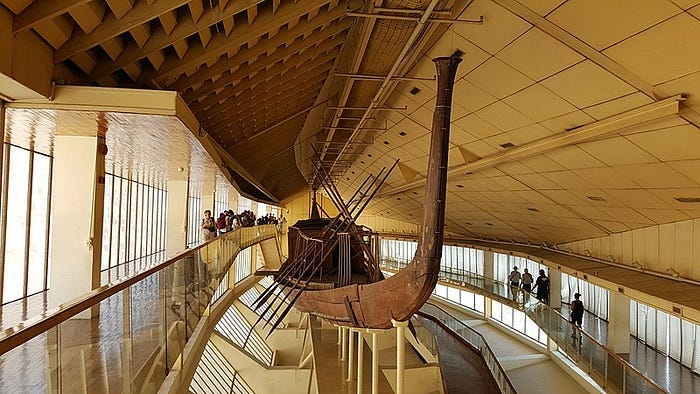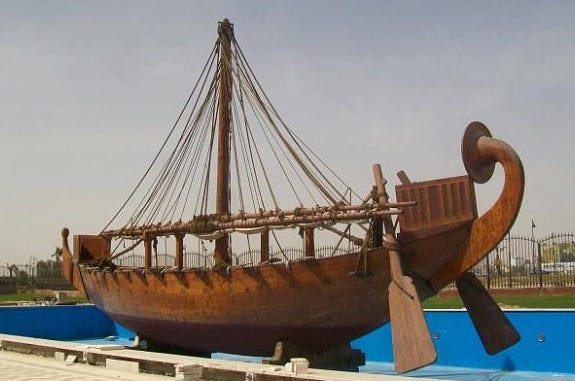They Rebuilt A 3500-Year-Old Ship To Retrace An Epic Egyptian Sea Voyage
Baboon mummies, ancient ships, and exotic lands

What images come to mind if I asked you to think of ancient Egypt? More than likely pyramids. Or perhaps a combination of sand, stone, pharaohs, and animal-headed gods.
Regardless, your mind focuses on land. Or at least mine does. Now, what if I told you the ancient Egyptians were a great seafaring people?
It sounds illogical. Egypt is an ancient spiritual kingdom, sitting in a desert. The only water associated with it is their famous Nile River. However, that’s only part of their story.
Joshua Mark at the World History Encyclopedia explains trade was a main factor of the kingdom’s growth. He says it had been firmly established in their Predynastic period (3150–2613 BC) with Mesopotamia and Phoenicia.
A few hundred years later Egypt stretched their arms out further, trading with Nubia and a far-off exotic land known as Punt. If the second doesn’t sound familiar, it’s for good reason. No one knows what Punt refers to.
Although drawings in various temples indicate a sea voyage with large ships was required to get there. Plus, it was fabulously rich. But the wonderous description of Punt and sketchy evidence of large Egyptian sailing ships made some question whether it really existed.
Well, until archeologists made a startling discovery in a now sand-covered ancient port of Mersa Gawasis near the coast of Egypt.
It has Egyptologists rethinking a legend and drove a couple experimental archeologists to recreate a grand ship based on an ancient drawing in a temple. But before we can get to the boat, we need to learn a bit about Punt.
A Female Pharaoh And A Powerful Sign
In the documentary When the Egyptians Sailed on the Red Sea, the story of Hatshepsut is examined. She was the eldest daughter of Pharaoh Thutmos I, and was married off to a half-brother, who was expected to take the throne. However, her husband soon died.
So, Hatshepsut stepped forward to become pharaoh. But, like today, there were constituencies to appease if one was to become ruler. Namely, the priestly class.
Historian Will Durant points out in Heroes of History, priests and pharaohs were co-dependents. The ruler elevated the priests to a higher status. In return, a powerful clergy promoted the pharaoh, who was thought to be a living god. But Hatshepsut had a bigger hurdle.
Being a woman, she’d have to do something grander to win acceptance by the priests. An answer came via the voice of a god. According to Joshua Mark, a relief at Hatshepsut’s temple reveals Amun-ra told her to find the way back to Punt.
While they had been long-term trading partners previously, by Hatshepsut’s reign around 1493BC, the connection was lost. She set about building five ships. They successfully made the journey in about twenty-five days and returned with an amazing bounty.
Mark says it included “heaps of incense, myrrh trees, ebony and ivory, gold, scented woods, incense, eye pigments, monkeys, baboons, dogs, and panther skins.” But the incense and myrrh may have been the biggest score.
They were the tools of the priests, and a large supply would likely ingratiate them to a future ruler. Plus, they could grow their own myrrh now. According to Mark:
“This exchange is the first time in recorded history that fauna (plants and trees) was successfully transplanted in another country. This transplant was so successful the trees flourished in Egypt for centuries. The roots of the trees brought back from Punt by Hatshepsut’s expedition in 1493 BCE can still be seen outside of her complex at Deir al-Bahri.”
Although many wondered if the story at Hatshepsut’s temple was more propaganda than truth. Then, the desert sand revealed a clue.
Evidence Of Sea Travel And An Experiment
During an excavation at Mersa Gawasis in Egypt around 2009, archeologist Kathryn Bard found wooden boxes buried in the sand. In the documentary When the Egyptians Sailed on the Red Sea, she reveals one carried markings which said, “The wonderful things of Punt.”
In a cave close by, there was another interesting discovery. Archeologist Cheryl Ward found dozens of heavy coiled ropes used for sailing, which were nearly four thousand years old. Her team later found many wooden planks. She believes these were from ships.
However, many in the archeological community met her findings with skepticism. Ward figured there’d only be one way to prove the theory: build a ship modeled from temple reliefs, with planks like that at Mersa Gawasis, and somewhat configured like Egyptian funeral boats.
Ward visited Luxor with fellow archeologist and ship builder Tom Vosmer to examine pictures of a large Egyptian sailing vessel on a temple wall. They calculated the length of the ship by scaling off the size of the crew manning the vessel. It was about twenty meters (nearly sixty-five feet).
They also visited various museums in Egypt with ancient river boats. Oddly, the hulls weren’t built around a skeleton or frame. They looked like random planks pressed together like a jigsaw puzzle without nails or fasteners.

Vosmer and Ward created a model, which they took to an old family-owned ship building company in Egypt. They’d have to relearn ancient techniques for the assembly. For instance, the planks were to be held together by a mortise and tenon joint system, no nails.
After ten months, and many leaks, the shipyard used an old method to seal the cracks between the beams of wood. They pressed linen between them. The shipbuilders also smeared beeswax over them, in ancient Greek style as well, and the boat held water.
Vosmer and Ward, along with an assembled crew, sailed the ship (nicknamed Min, after an Egyptian deity) out on the Red Sea, hitting speeds of eight knots. While a bit shaky, it handled reasonably.

They also proved the ship could tack against the wind and was surprisingly maneuverable for a flat-bottomed boat on the sea. The team surmised the Egyptians would have sailed by day and pulled the boats ashore by night.
The archeologists also believe skilled Egyptian sailors could have made a long voyage. Although Punt remains elusive. But a strange source might point to a destination.
Baboon Mummies May Point To Punt
Stephanie Pappas at Live Science explains the ancient Egyptians were fascinated with baboons, and many of their mummified corpses are found throughout the kingdom. It’s believed they were kept as pets and used in temple rituals.
Pappas interviewed Nathaniel Dominy, a primatologist in Darthmouth College who says baboons aren’t native to Egypt. While the Egyptians themselves claim they came from Punt. This led Dominy to examine some of the mummies.
He reveals by studying “variations of strontium and oxygen in the animals’ tissues” you can get a type of GPS locater. Water and foods from different locations imprint themselves in unique ways within the tissue when a creature is young. So, it’ll show you where an animal was born.
The baboons from the New Kingdom period (1520 B.C. to 1075 B.C.) appear to have come from “the region that is modern-day Eritrea, Ethiopia and Somalia.” Later baboons from Ptolemy’s reign grew up in Egypt — possibly bred in captivity.
But Dominy cautions that this was just a preliminary study, and more work must be done.
Although if you start adding the series of curious findings: wooden planks, coils of rope, cargo boxes marked “Punt,” wall reliefs showing great sailing ships, and isotopes from distant animals, it starts to paint a picture. One involving a sea-capable trading empire.
So, in the future we may just add ships to that initial vision of sand, pyramids, pharaohs, and animal-headed gods.
-Originally published on Medium 4/27/23


